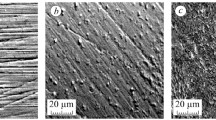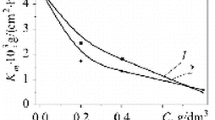The mechanism of formation of protective films on the steel surface in the course of its treatment by the extract of rapeseed (Brassicaceae family) cake regarded as a volatile corrosion inhibitor and its component composition are experimentally determined and theoretically substantiated. The dynamics of changes in the component composition of volatile compounds in the 2-propanol extract of rapeseed cake is studied by the methods of gas chromatography, mass spectrometry, and IR-spectroscopy. The influence of individual components on the corrosion behavior of steel under the conditions of periodic condensation of atmospheric moisture is investigated. It is shown that the main components of the 2-propanol extract responsible for its anticorrosion efficiency are aldehydes, ketones, and glycosides. A model of the structure of protective films is proposed.





Similar content being viewed by others
References
N. N. Andreev and Yu. I. Kuznetsov, “Volatile inhibitors of atmospheric corrosion,” Korros.: Mater., Zashch., No. 3, 26–29 (2004).
А. I. Altsybeeva, V. V. Burlov, N. S. Fedorova, and T. M. Kuzinova, “Volatile inhibitors of atmospheric corrosion of ferrous and nonferrous metals. III. VNKh-L-408 inhibitor: basics of production and application technology,” Int. J. Corr. Scale Inhib., 2, No. 1, 9–16 (2013).
S. S. Viswanathan, “A review on recent patents in corrosion inhibitors,” Recent Patents Corr. Sci., 2, 6–12 (2010).
B. R. Pandian and G. S. Mathur, “Natural products as corrosion inhibitor for metals in corrosive media—A review,” Mater. Lett., 62, No. 1, 113–116 (2008).
A. M. Abdel-Gaber, B. A. Abd-El-Nabey, and M. Saadawy, “The role of acid anion in the inhibition of the acidic corrosion of steel by lupine extract,” Corr. Sci., 51, No. 5, 1038–1042 (2009).
N. Poongothai, P. Rajendran, M. Natesan, and N. Palaniswamy, “Wood bark oils as vapor-phase corrosion inhibitors for metals in NaCl and SO2 environments,” Indian J. Chem. Technol., 12, 641–647 (2005).
O. E. Chyhyrynets’ and V. I. Vorob’iova, “Anticorrosion properties of the extract of rapeseed oil cake as a volatile inhibitor of the atmospheric corrosion of steel,” Mater. Sci., 49, No. 3, 318–325 (2013).
E. E. Chigirinets, V. I. Vorob’iova, N. V. Shalyga, and S. Yu. Lipatov, “Chromato-mass-spectral analysis of the volatile fractions of the 2-propanol extract of rape,” Ukr. Khim. Zh., 79, No. 10, 8–14 (2013).
N. P. Zhuk, A Course of the Theory of Corrosion and Protection of Metals [in Russian], Metallurgiya, Moscow (1976).
Y. Xiao-Ci, Z. Hong, L. Ming-Dao, R. Hong-Xuan, and Y. Lu-An, “Quantum chemical study of the inhibition properties of pyridine and its derivatives at an aluminum surface,” Corr. Sci., 42, 645–653 (2000).
Author information
Authors and Affiliations
Corresponding author
Additional information
Translated from Fizyko-Khimichna Mekhanika Materialiv, Vol. 50, No. 5, pp. 91–100, September–October, 2014.
Rights and permissions
About this article
Cite this article
Vorob’iova, V.I., Chyhyrynets, O.E. & Vasyl’kevych, O.I. Mechanism of Formation of the Protective Films on Steel by Volatile Compounds of Rapeseed Cake. Mater Sci 50, 726–735 (2015). https://doi.org/10.1007/s11003-015-9778-z
Received:
Published:
Issue Date:
DOI: https://doi.org/10.1007/s11003-015-9778-z




